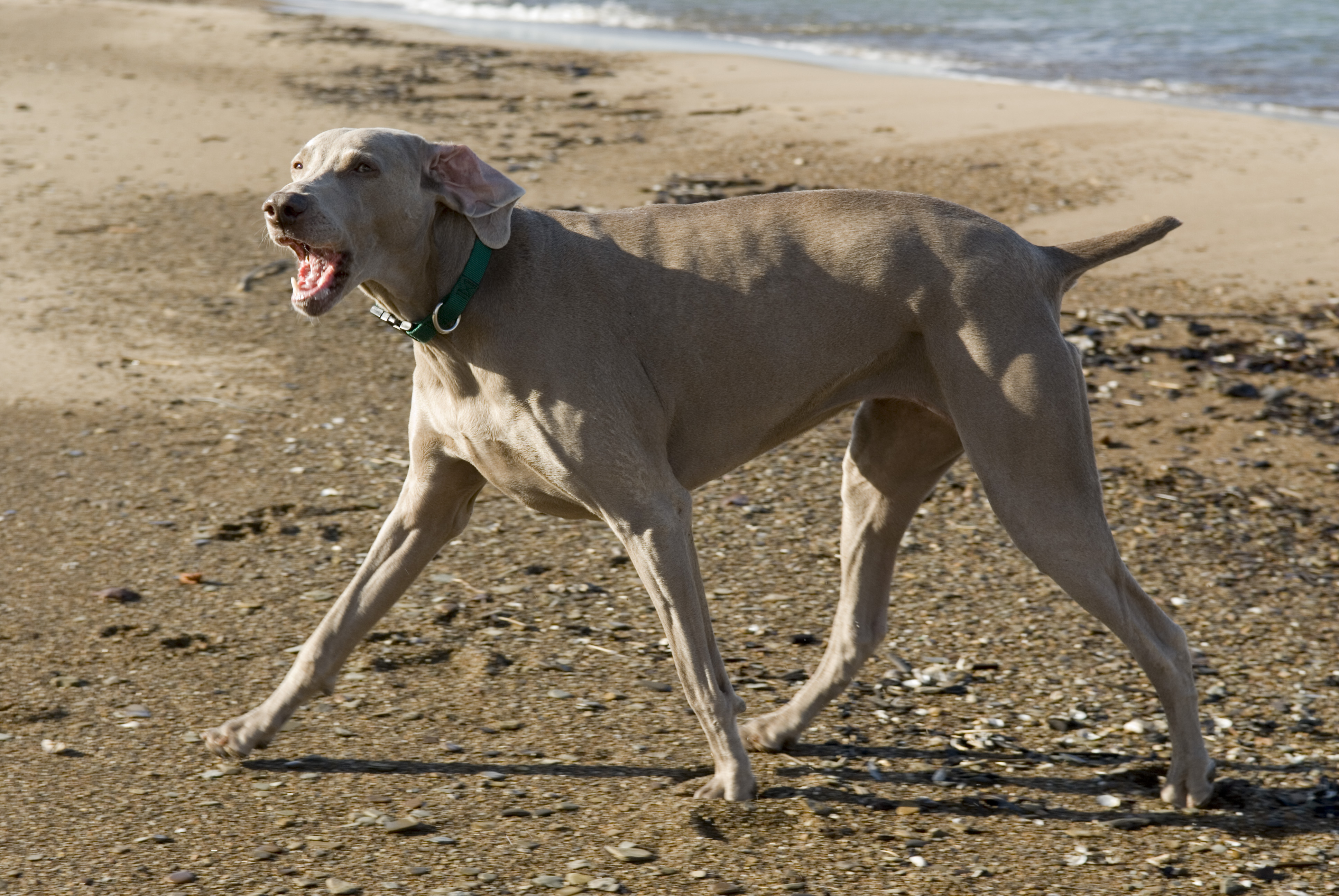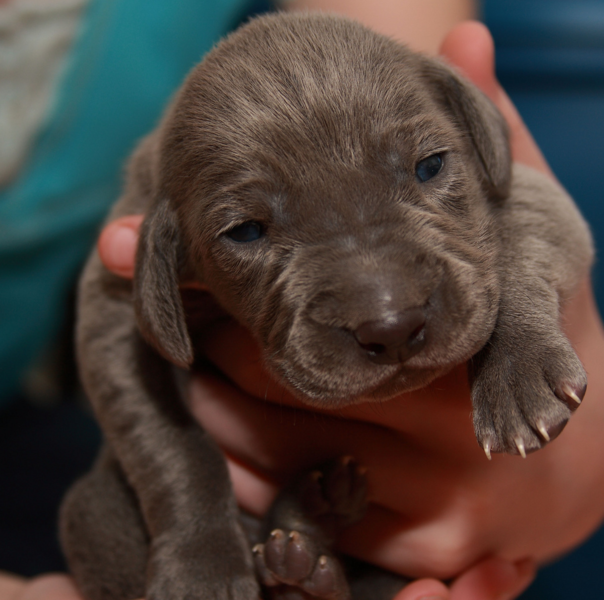
Weimaraner dog
Weimaraner breed dog is brave and intelligent dog, Weimaraner dog is rare breed, Weimaraner dog is hunting dog, Weimaraner dog has good feel and search.
Weimaraner - young breed, originated in the early XIX century. Modern Weimaraner - a product of crossing different breeds, with careful screening and selection to fix the desired type and working qualities. Ancestors of the breed were the same dog from which there was a german haired pointer. Since then, the increased height at the Weimaraner dog withers and weight Weimaraner, but the characteristic color, which is described as silvery gray hair or a mouse-gray, has remained virtually the same. Breed took care of the palace know Weimar. These gentlemen, long familiar with different types of hunting, conceived to combine in one dog, the qualities that they find useful for hunting abounding in those days in Germany's game. In short, the dog must have had a good feel, and search, and to be brave and intelligent.
Progenitors Weimaraner was used as the etching of dogs in hunting big game: wolves, wild cats, deer, bears, etc. By the time this production has become rare breed of enthusiasts formed an organized club, which was the first description of the dog. Club members were amateur hunters who sought to create a working breed and not for profit. As a result, buy a Weimaraner was difficult even in Germany and in other countries - almost impossible. Before you buy a dog, it was necessary to become a member of the club and club membership required from the candidate of unconditional compliance with the rules of breeding species. One of them says that the offspring of dogs that inspection of the club found it unsuitable, not entered in the studbook, others insisted on the destruction of dogs - even from the litter, the approved inspection - exterior and temperament which does not conform to the breed. Of course, in such circumstances Weimaraner could not get wide distribution

Weimaraner dog
Weimaraner dog is easy trained dog, Weimaraner dog is intelligent and active dog.
The United States met with Weimaraner in 1929, when members of the German Weimaraner Club was an American hunter and dog breeder Howard Knight. He was allowed to take two puppies, and Knight was the founder of the American Weimaraner Club and its first president. The club tried to work on the same principles that helped to preserve the purity of the breed in its homeland, Germany.
It is worth mentioning that after the Weimaraner dog disappearance of big game in Germany, the Weimaraner coached for upland game and field, and also used as a retriever for hunting ducks, as he was known for his ponoskoy. And in America, and Germany Weimaraner was used mainly for hunting practice, rather than competition and field trials.
In the U.S., aroused interest in the Weimaraner first competition in training before, in 1943 recognized the breed American Kennel Club. Female Weimaraner received in 1941 three times the degree C.D1. Later, another dog under the age of 10 months, got all the power on all types of tests, but work on the trail. Curiously, in America, Weimaraner often participated in various trials and competitions than in all the decades of the breed in Germany.
With regard to character, then that dog should not be kept in an aviary or nursery. It must be a member of the family and pleased to assume all responsibilities, which is entrusted with

Weimaraner dog
Weimaraner puppies are cute and friendly dog, Weimaraner dog is aristocratic, Weimaraner dog looks graceful.
Weimaraner. Official Standard
Approved December 14, 1971
General view. Weimaraner - a dog of medium size, gray color, with chiselled aristocratic features. Looks graceful, agile, sturdy and perfectly folded. General view veyma-
Companion Dog - Companion Dog.
Rahner demonstrates his ability to work in a field with great speed and endurance.
Growth. Height: Males - 63.5 - 68.5 cm, females - 58.5 - 63.5 cm
Flaws: height deviations within 2,5 cm
ELIMINATING FAULTS: Dogs - less than 61 cm or more than 71 cm, females - less than 56 cm or more than 66 cm
Head of medium length, aristocratic, with moderate transition from forehead to muzzle and easy groove, passing along his forehead. Occipital bone pronounced. Distance from nose to the transition from forehead to muzzle the distance from the transition from forehead to muzzle to occiput. Lips dry, tight, thin. Leather skinny head. Expression of the eyes is good, insightful, lively and intelligent. Ears set high, long-lopasteob different, slightly pleated, extended along the muzzle, ears do not reach the nose by about 5 cm's eyes light amber, gray or bluish-gray, set wide apart and point to a good disposition and intelligence ; in the excited state pupils dilate, the eyes are almost black. Teeth large, cutters are on the Weimaraner dog same line, are proportional to the size of the jaw. Scissor bite. Preferred full set of teeth. Nose gray. Lips and gums pinkish flesh-colored.
Corps of medium length, straight topline, strong, slightly sloping from withers to base of tail. Chest strong, deep, with sloping shoulders. Ribs long, rather convex. Picked up a groin, abdomen slightly tucked. Sternum lowered to the elbow

Weimaraner dog
Weimaraner dog is straight and shiny, Weimaraner dog looks aristcratic and powerful.
Coat and color. The Weimaraner dog coat is short, straight, tight,
shiny, solid color on mouse-gray to silvery-gray colors on the head and
ears are usually lighter tones. A small amount of white on the chest.
Faults: White spots on other parts of the body.
Disqualifying faults: a long coat. Blue or black color. The forelegs are straight and strong. Distance from the elbow to the chest is approximately equal to the distance from the withers to the elbow.
Hindquarters well-muscled. Angulation of the knee are well expressed. Hocks straight.
Feet are hard and compact, with webbed, arched, pads thick, nails short and gray or amber. Dewclaws removed.

Weimaraner dog
Tail docked. The Weimaraner dog adult dog it should be up to 15 cm, more easy than hard. The dog has his calm and confident, demonstrating a balanced character.
Flaws: Undocked.
Movements are free, well-coordinated. When observing the rear hind legs should move parallel to the front. When viewed from the side of the back should remain straight and strong.
Temperament. Nature friendly, fearless, lively and docile. Vices
Disadvantages: too short or too long tail. Pink nose.

Weimaraner dog
Vices: Dogs in suchem, bitches doggy style; underdevelopment muscles; caries, the absence of more than four teeth, shortened or extended format, sway or roach back; uncharacteristic coat, too short, thick neck or a suspension, tail set low; turned in or out elbows; outwards, clubfoot, pacing, weak legs; Cowhocks, undershot or overshot, pointed snout, short ears.
Very serious flaws: the white spots on any part of the body except the chest and his eyes any color except gray, bluish-gray or light amber, black mottled mouth; Undocked; manifestation of timidity or cowardice.
ELIMINATING FAULTS
Deviation from the height at the withers by more than 2.5 cm in one direction or another.
Long coat. Blue or black color
Faults: White spots on other parts of the body.
Disqualifying faults: a long coat. Blue or black color. The forelegs are straight and strong. Distance from the elbow to the chest is approximately equal to the distance from the withers to the elbow.
Hindquarters well-muscled. Angulation of the knee are well expressed. Hocks straight.
Feet are hard and compact, with webbed, arched, pads thick, nails short and gray or amber. Dewclaws removed.
Weimaraner dog
Tail docked. The Weimaraner dog adult dog it should be up to 15 cm, more easy than hard. The dog has his calm and confident, demonstrating a balanced character.
Flaws: Undocked.
Movements are free, well-coordinated. When observing the rear hind legs should move parallel to the front. When viewed from the side of the back should remain straight and strong.
Temperament. Nature friendly, fearless, lively and docile. Vices
Disadvantages: too short or too long tail. Pink nose.

Weimaraner dog
Vices: Dogs in suchem, bitches doggy style; underdevelopment muscles; caries, the absence of more than four teeth, shortened or extended format, sway or roach back; uncharacteristic coat, too short, thick neck or a suspension, tail set low; turned in or out elbows; outwards, clubfoot, pacing, weak legs; Cowhocks, undershot or overshot, pointed snout, short ears.
Very serious flaws: the white spots on any part of the body except the chest and his eyes any color except gray, bluish-gray or light amber, black mottled mouth; Undocked; manifestation of timidity or cowardice.
ELIMINATING FAULTS
Deviation from the height at the withers by more than 2.5 cm in one direction or another.
Long coat. Blue or black color
Няма коментари:
Публикуване на коментар